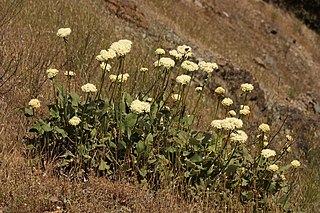
Eriogonum is a genus of flowering plants in the family Polygonaceae. The genus is found in North America and is known as wild buckwheat. This is a highly species-rich genus, and indications are that active speciation is continuing. It includes some common wildflowers such as the California buckwheat.

Penstemon barbatus, known by the common names golden-beard penstemon, and beardlip penstemon, is a flowering plant native to the western United States. In Spanish-speaking New Mexico and southern Colorado, it is called varita de San Jose – "St. Joseph's staff".

Eriogonum fasciculatum is a species of wild buckwheat known by the common names California buckwheat and flat-topped buckwheat. Characterized by small, white and pink flower clusters that give off a cottony effect, this species grows variably from a patchy mat to a wide shrub, with the flowers turning a rusty color after blooming. This plant is of great benefit across its various habitats, providing an important food resource for a diversity of insect and mammal species. It also provides numerous ecosystem services for humans, including erosion control, post-fire mitigation, increases in crop yields when planted in hedgerows, and high habitat restoration value.

Atriplex canescens is a species of evergreen shrub in the family Amaranthaceae native to the western and midwestern United States.

Lithospermum incisum is a species of flowering plant in the borage family known by several common names, including fringed puccoon, narrowleaf stoneseed, fringed gromwell, narrowleaf puccoon, and plains stoneseed. It is native to much of central Canada and the United States, where it is known from many types of habitat, but particularly piñon-juniper woodland. It is a hairy perennial herb growing from a taproot and woody caudex. It produces a cluster of stems up to about 30 centimeters long. The stems are lined with narrow, pointed leaves up to 6 centimeters long. The slender, trumpet-shaped flowers are pale to bright yellow or gold, and may approach 4 centimeters long. The corolla face is 1 to 2 centimeters wide, its lobes sometimes ruffled. The smaller cleistogamous (closed) flowers are the main producers of seed.

Amsonia tomentosa is a species of flowering plant native to the southwestern United States and northern Mexico (Chihuahua). Its common names include woolly bluestar and gray amsonia.

Atriplex argentea is a species of saltbush known by the common names silverscale saltbush and silver orache. It is native to western North America from southern Canada to northern Mexico, where it grows in many types of habitat, generally on saline soils.

Mirabilis multiflora is a species of flowering plant in the four o'clock family known by the common name Colorado four o'clock that is native to the southwestern United States from California to Colorado and Texas, as well as far northern Mexico, where it grows in mostly dry habitat types in a number of regions.

Orobanche fasciculata is a species of broomrape known by the common name clustered broomrape. It is native to much of western and central North America from Alaska to northern Mexico to the Great Lakes region, where it grows in many types of habitat. It is a parasite growing attached to the roots of other plants, usually members of the Asteraceae such as Artemisia; and other genera such as Eriodictyon and Eriogonum. This plant produces one or more stems from a bulbous root, growing erect to a maximum of about 20 centimeters in height. The stems, leaves and five-lobed flowers are covered by sticky hairs. As a parasite taking its nutrients from a host plant, it lacks chlorophyll as well as a water-storage system. It is variable in color, often yellowish or purple. The inflorescence is a raceme of up to 20 flowers, each on a pedicel up to 15 centimetres long. Each flower has a calyx of hairy triangular sepals and a tubular corolla 1.5–3 cm long. The flower is yellowish or purplish in color.

Phoradendron juniperinum is a species of flowering plant in the sandalwood family known by the common name juniper mistletoe. It is native to the southwestern United States and northern Mexico, where it grows in various types of woodland habitat. It has been reported from California, Nevada, Arizona, New Mexico, Oregon, Utah, Texas, Chihuahua and Sonora.

Rumex salicifolius is a species of flowering perennial plant in the knotweed family known by the common names willow dock and willow-leaved dock. It is native to much of western North America, and more specifically, in southern and central parts of California, and some parts of Arizona and Nevada. It can also be found in parts of Europe as an introduced species and a roadside weed. It is an extremely variable plant which is generally divided into many varieties, some of which may actually be specimens of other species.
This is a list of plants used by the indigenous people of North America. For lists pertaining specifically to the Cherokee, Iroquois, Navajo, and Zuni, see Cherokee ethnobotany, Iroquois ethnobotany, Navajo ethnobotany, and Zuni ethnobotany.
See also Zuni ethnobotany, and Native American ethnobotany.
This is a list of plants and how they are used in Zuni culture.
Asclepias involucrata, common name dwarf milkweed, is a plant found in the American southwest.
Pomaria jamesii, is a plant found in the American southwest.
Dalea compacta, with the common name compact praireclover, is a plant of the Southwestern United States.

Castilleja integra, with the common name wholeleaf Indian paintbrush, is an herbaceous perennial plant native to the Southwestern United States.

Cryptantha cinerea is a plant found in the United States.

Eriogonum alatum, with the common names winged buckwheat and winged eriogonum, is a species of buckwheat.













